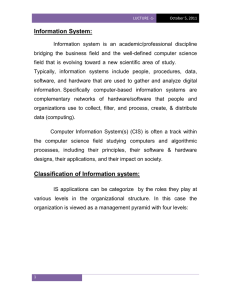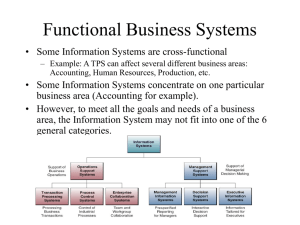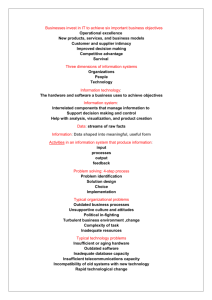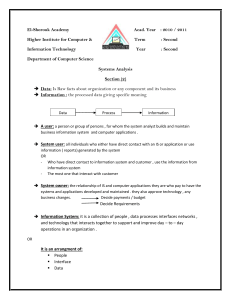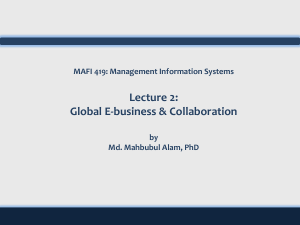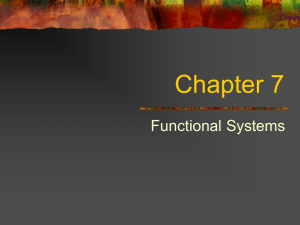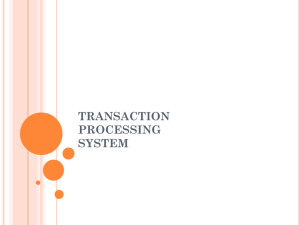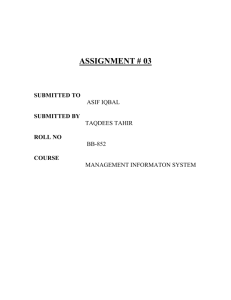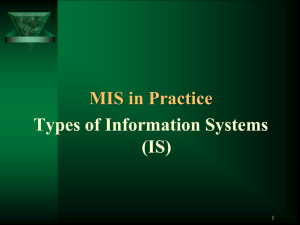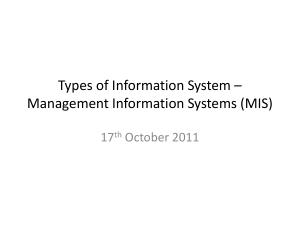How do information systems support the major business functions?
advertisement
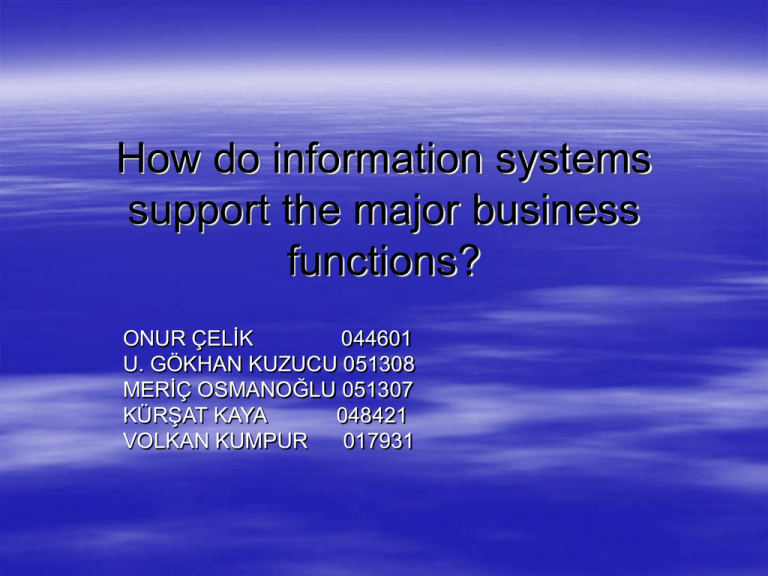
How do information systems support the major business functions? ONUR ÇELİK 044601 U. GÖKHAN KUZUCU 051308 MERİÇ OSMANOĞLU 051307 KÜRŞAT KAYA 048421 VOLKAN KUMPUR 017931 LEARNING OBJECTIVES • Define and describe business processes and their relationship to information systems. • Describe the information systems supporting the major business functions: sales and marketing, manufacturing and production, finance and accounting, and human resources. • Evaluate the role played by systems serving the various levels of management in a business and their relationship to each other. LEARNING OBJECTIVES (cont.) How Businesses Use Information Systems List of Some Major Information Systems WHAT IS INFORMATION SYSTEM? An information system (IS) is an arrangement of people, data, processes, and information technology that interact to collect, process, store, and provide as output the information needed to support an organization. A management information system (MIS) is an information system that provides for managementoriented reporting based on transaction processing and operations of the organization. Types of Information Systems A transaction processing system (TPS) is an information system that captures and processes data about business transactions. A management information system (MIS) is an information system that provides for managementoriented reporting based on transaction processing and operations of the organization. A decision support system (DSS) is an information system that either helps to identify decision making opportunities or provides information to help make decisions. Types of Information Systems (cont.) An expert system is an information system that captures the expertise of workers and then simulates that expertise to the benefit of non-experts. A communications and collaboration system is an information system that enables more effective communications between workers, partners, customers, and suppliers to enhance their ability to collaborate. An office automation system is an information system that supports the wide range of business office activities that provide for improved work flow between workers. Transaction Processing System – Serve operational managers – Principal purpose is to answer routine questions and to track the flow of transactions through the organization E.g. Inventory questions, granting credit to customer – Monitor status of internal operations and firm’s relationship with external environment – Major producers of information for other systems – Highly central to business operations and functioning Management Information System – Provide middle managers with reports on firm’s performance To monitor firm and help predict future performance – Summarize and report on basic operations using data from TPS – Provide weekly, monthly, annual results, but may enable drilling down into daily or hourly data – Typically not very flexible systems with little analytic capability Management Information System (cont.) Mid-level managers. Uses high volume data. E.g. Budgeting. Decision Support System – Support non-routine decision making for middle management E.g. What would impact on production schedules be if sales doubled in December? – Use information from TPS, MIS, and external sources – Use models to analyze data E.g. voyage estimating system of metals company that calculates financial and technical voyage details – Focus on extracting, analyzing information from large amounts of data Decision Support Systems (cont.) Used by management level. Users are professionals. Evaluates low volume data. Executive Support Systems – Serve senior managers – Address strategic issues and long-term trends E.g. What products should we make in 5 years? – Address non-routine decision-making – Provide generalized computing capacity that can be applied to changing array of problems – Draw summarized information from MIS, DSS and data from external events – Typically use portal with Web interface to present content Executive Support Systems (cont.) It is used by strategic management level. Uses all collected data. Evaluates future projections. How MIS Obtain Data From TPS How MIS Obtain Data From TPS For Example (from previous slight): Transactions Processing System can be considered as raw material... Management Informatin System can be considered as semi-finished product... The information leaves from MIS Files can be considered as finished product... Sample MIS Report How Do We Apply Information Systems to Businesses Many companies use their own Business Information Model (BIM) to define the major business functions of their companies. In order to define a model, they devide their business functions into 2 main group. How Do We Apply Information Systems to Businesses (cont.) How Do We Apply Information Systems to Businesses (cont.) Primary functions are needed to develop and deliver products or services. Support functions are needed to perform in order to support primary functions. Relationship Between Systems TPS: Major source of data for other systems ESS: Primarily a recipient of data from lowerlevel systems Other systems may exchange data as well Exchange of data between functional areas – E.g. Sales order transmitted to manufacturing system In most organizations, systems are loosely integrated Interrelations Between Systems List of Major Information Systems Lawrence Berkley Laboratory National Energy Research Scientific Computing Enclave: The Lawrence Berkley Laboratory National Energy Research Scientific Computing (NERSC) Enclave system is in Support of Advanced Scientific High Performance Computing. List of Major Information Systems (cont.) Environmental Management Headquarters EM 20 RADCALC: This application is used by National Transportation Program to support the planning and execution of its transportation responsibilities for all non-classified shipments of hazardous materials, including radioactive, mixed wastes, and other commodities in support of environmental site clean-up activities. List of Major Information Systems (cont.) Management, Budget & Evaluation Procurement and Assistance Data System (PADS): A Headquarters procurement-based system associated with planning, awarding, and administering various unclassified acquisitions. Thank You for Listening…

